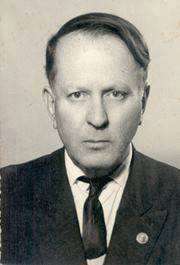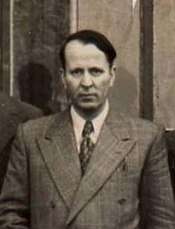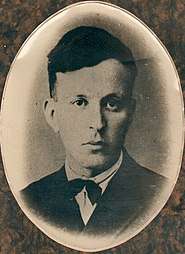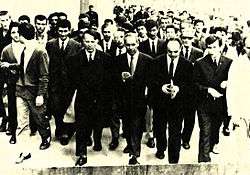Nihal Atsız
Hüseyin Nihâl Atsız (Ottoman Turkish: حسين نيهال آتسز; January 12, 1905 – December 11, 1975)[5][6] was a prominent Turkish nationalist writer, novelist, poet and philosopher. Nihâl Atsız identified as a racist, Pan-Turkist and Turanist,[7] and was claimed to be a sympathizer of the Nazi government,[7][8] but he denied it.[9] He was the author of over 30 books and numerous articles. He was in strong opposition to the government of İsmet İnönü, which he criticized for co-operating with the communists.[10] He was accused of plotting to overthrow the government.[11]
Nihâl Atsız | |
|---|---|
 | |
| Born | Mehmet Nail oğlu Hüseyin Nihâl January 12, 1905 Kadıköy, Istanbul, Ottoman Empire[1][2][3][4] |
| Died | December 11, 1975 (aged 70) İçerenköy, Istanbul, Turkey |
| Resting place | Karacaahmet Cemetery, Istanbul |
| Occupation | Writer, novelist, poet and philosopher |
| Education | History of literature |
| Notable works | Bozkurtların Ölümü (Death of the Grey Wolves) |
| Spouse | Mehpare Hanım (1931–35) Bedriye Atsız (1936–75) |
| Children | 3 |
| Part of a series on |
| Nationalism |
|---|
|
Core values |
|
|
Organizations |
|
Related concepts
|
|
Personal life

Nihâl Atsız was born on January 12, 1905 at Kasımpaşa, Istanbul. His father was navy commander Mehmet Nail Bey, from the Çiftçioğlu family of Torul, Gümüşhane; and his mother was Fatma Zehra, daughter of navy commander Osman Fevzi Bey, from the Kadıoğlu family of Trabzon. Nihâl Atsız had two sons from his second wife Bedriye Atsız: Yağmur Atsız, a left-wing journalist and writer, and Prof. Dr. Buğra Atsız, academician and nationalist writer; he also had a daughter: Kaniye Atsız. Atsız had a younger brother, Nejdet Sançar, also a prominent personality of the Pan-Turkist ideology.[12]
Education and professional life
He first studied at the Military School of Medicine but was expelled due to his ultra-nationalist views and activities. He then began to study at the Teachers College in Istanbul and the Istanbul University School of Literature and graduated from both in 1930. Following he became assistant to Professor Fuat Köprülü at the Istanbul University.[13] He challenged the Turkish History Thesis and following this incident he was dismissed from the University. After he worked in different high schools as a teacher and was a researcher at the Süleymaniye Library from 1949 until 1969. After his retirement in 1969 he kept publishing Ötüken.[14]
Publishing
Atsız was a publisher of several magazines. Atsız published several academic essays about Ottoman literature and history. He began to publish magazines in 1931, which he kept doing until 1975. Atsız Mecmua was the first Pan-Turk magazine, which was published from 15 May 1931 to 25 September 1932.[15] He also published Orhun from 1933 to 1934 and again from 1943 to 1944.[16] Orkun was first published in 1950. His last magazine Ötuken was published from 1964 to 1975.[17]
Politics

Nihâl Atsız was an important ideologue who lived during the early years of the Republic of Turkey. His circle attacked Atatürk's leadership, condemned Turkey's foreign policy, and particularly the appeasement policy vis-a-vis the Soviet Union. Most importantly, his supporters ridiculed Kemalist attempts at building a civic nation model in the Early Republican Era. However, he also praised Atatürk after Democratic Party's dismiss in 1960.
He was foremost known for his nationalist views, his active campaign against Turkish communists, and his embracing of Tengriistic ancient Turkic traditions. Atsız viewed racism and pan-Turkism as the two main components of Turkish nationalism and disputed the ideologues of the likes of Ziya Gökalp or Hamdullah Suphi Tanriöver who didn't share his views regarding racism,[18] however, according to him, racism "is not about measuring head, analysing blood or counting seven ancestors as a couple of phony zanies claimed".[19] He was among the authors that influenced a type of Turkish nationalism known as Ülkücü movement (translated as "idealist"), a nationalist movement later associated to Alparslan Türkeş (and which was a break with Atsız's previous ideology of Pan-Turkism, on the grounds that it reconciles with Islam instead of denouncing it as "Arab religion", which Atsız previously stated).[20] He wrote that the Kipchaks in Lithuanians and Kirghiz are from the same blood and therefore Turks, but "alien people" living in Turkey like Jews or Negroes are not Turks even if they speak Turkish.[16]
Kemalism, which had been condemned so harshly in his novel "Dalkavuklar Gecesi" (Night of the Sycophants) is the founding ideology of the Republic of Turkey. The nature and the type of Kemalist nationalism during the Early Republican Period (1923–50) had since 1923 have interpreted Turkish identity under the guiding light of constitutional principles which equated ‘Turkishness’ with being a Turkish citizen. Identifying all Turkish citizens as Turks proper, the three constitutions of the Republican Era were completely and positively blind to ethnic, and religious differences between Turkish citizens and disassociated ‘Turkishness’ from its popular meaning: that is, the name of an ethnic group. Supporters of this view argue that Republican statesmen rejected the German model of ethnic nationalism and emulated the French model of civic nationalism by reducing ‘Turkishness’ to a legal category only. In other words, citizens of Turkey who happened to be of Kurdish, Greek, Armenian, Jewish or Assyrian descent had only to accept a plebiscite, according to this view, to take advantage of the opportunity of Turkification, as far as their citizenship status was concerned, and gaining full equality with ethnic Turks, provided that they remained faithful to their side of the bargain.[21]
Atsız and his comrades published several Pan-Turkist magazines such as Ötüken, Yeni Hayat and Orkun. He wrote strong articles which criticized the government of İsmet İnönü and his alleged tolerance of communism in the country.
In 1934, he had written that "the Jew" was among "the internal enemies of Turkey" but in 1947, he praised the Jewish people for setting an example of strong nationalism (Zionism): indeed, the Jews managed "to get back the land they had lost 2,000 years ago and to revive Hebrew which has remained only in the books and turn into a spoken language."[22]
He thought Turks and non-Turks should not intermarry and love has not the same value as nationalist feelings. He further believed nationalism was superior than religion and Islam was a manifestation of the struggle of the Arabs to form a nation.[23]
Legal prosecution

In 1944 Atsız was prosecuted together with more than 30 others, amongst them also Alparslan Türkeş, for racism and pan-Turanism. He first got sentenced to 6 years and 6 months in prison, after the sentence was lowered to 1 year and 6 months and at the end he received an amnesty.[24] 1973 he received a prison sentence because of his writings against Kurds. He wrote Kurds should leave Turkey and learn from the Armenians what happens to the people who challenge the Turkish nation. After 2 1/2 months in prison, he was pardoned by the President Fahri Korutürk.[25]
His legacy
Nineteen young academicians and authors, assembled under a nationalist association "Siyah Beyaz Kültür ve Sanat Platformu", published a book on him, "Vaktiyle Bir Atsız Varmış",[26] consisted of articles and comparative studies on his works, life and views.
Political groups
In Turkey in 2012 a nationalist group calling itself "Genç Atsızlar" ("Young Atsızes") emerged, participating in anti-Armenian demonstrations in Istanbul, carrying banners stating "You are all Armenians, You are all bastards", in response to the slogan "We are all Hrant Dink, We are all Armenians".[27][28] In February 2015, in response to the 100th anniversary of the Armenian Genocide, Anti-Armenian banners of Genç Atsızlar appeared in cities around Turkey, including banners in İstanbul condemning the Khojaly Genocide, and a banner in Muğla proclaiming "We celebrate the 100th anniversary of our country being cleared of Armenians".[29]
Literary Work
His essays about history are gathered and published as a book under the name of Türk Tarihinde Meseleler (Issues in Turkish History). He also served as a literature teacher for a number of years.
A famous politicised novel of his was Dalkavuklar Gecesi (Night of the Sycophants), a historical allegory and critique of Kemalism.[21] Published in 1941, it tells the story of political corruption during the Hittite era but actually referring (in a roman a clef fashion) to the injustices and arbitrariness of Atatürk's rule during the early 1930s.
Atsız is also an important novelist and poet. His historical epic novel Bozkurtların Ölümü (Death of the Grey Wolves) is one of the most popular historical novels in Turkish literature. The book concerns the last days of the first Gök Türk Empire and the impossible rebellion of Prince Kür-Şad and his forty warriors against the Chinese invaders, referring to the attempt to kidnap the Chinese emperor by Ashina Jiesheshuai in 639. His original Turkic name is unknown, Kürşad is a made-up name by Atsız. Its sequel Bozkurtlar Diriliyor (Revival of the Grey Wolves) tells the story of Urungu (the unknown son of Kür-Şad) and the beginning of the second Gök Türk Empire. His third novel, Deli Kurt (Mad Wolf), is about the mystic romance between a Sipahi warrior and a mysterious shamanist nomad woman in the early Ottoman Empire.
Atsız wrote a satirical political comedy about the İnönü government, Z Vitamini (Vitamin Z), which was about a fictional special vitamin which gives immortality to the dictator and his government. It was published in 1959.
His last novel, Ruh Adam (Soul Man), is quite a complex psychological novel. The book has a spiritual and mystical atmosphere, full with surrealistic, allegorical figures such as Yek (who symbolizes Satan) and Lieutenant Şeref (who symbolizes Honour). It has a complex story, which is generally about the forbidden platonic love affair between an alcoholic ex-army officer and a diabolical, mysterious young high school student. The plot develops on the reincarnation of two lovers, which was a warrior banned from the army because of his love to the girl was greater than his love to his country in ancient nomad times.
His poems are in the style of Pre-Islamic literature and his common themes are idealism, honour, forbidden love, war and history. His complete poetic works have been published under the name of Yolların Sonu ("End of Roads").
Works
Novels
- Dalkavuklar Gecesi (Night of the Sycophants), İstanbul 1941. ISBN 978-975-437-804-7
- Bozkurtların Ölümü (Death of the Grey Wolves), İstanbul 1946. ISBN 978-975-437-800-9
- Bozkurtlar Diriliyor (Revival of the Grey Wolves), İstanbul 1949. ISBN 978-975-437-800-9
- Deli Kurt (Mad Wolf), İstanbul 1958. ISBN 978-975-437-801-6
- Z Vitamini (Vitamin Z), İstanbul 1959. ISBN 978-975-437-804-7
- Ruh Adam (Soul Man), İstanbul 1972. ISBN 978-975-437-802-3
Stories
- 'Dönüş' (The Return), In Atsız Mecmua, sayı.2 (1931), Orhun, Sayı.10 (1943)
- 'Şehidlerin Duası' (Prayer of Martyrs), In Atsız Mecmua, Sayı.3 (1931), Orhun, Sayı.12 (1943)
- 'Erkek Kız' (Tomboy), In Atsız Mecmua, Sayı.4 (1931)
- 'İki Onbaşı, Galiçiya...1917...' (Two Corporals, Galicia...1917...), In Atsız Mecmua, Sayı.6 (1931), Çınaraltı, Sayı.67 (1942), Ötüken, Sayı.30 (1966)
- 'Her Çağın Masalı: Boz Doğan ve Sarı Yılan' (Tale of All Ages: Grey Hawk and Yellow Snake), In Ötüken, Sayı.28 (1966)
Poem
- 'Yolların Sonu' (End of Roads), İstanbul 1946. ISBN 978-975-437-806-1
Other works
- Divan-ı Türk-i Basit, Gramer ve Lugati (Divan-ı Türk-i Basit, Grammar and Dictionary), Graduating Thesis, Institute of Turkology, no. 82, 111 pages (İstanbul, 1930)
- "Sart Başı"na Cevap (Answer to Head of Sart), İstanbul, 1933.
- Çanakkale'ye Yürüyüş (Walking to Çanakkale), İstanbul, 1933.
- XVIıncı asır şairlerinden Edirneli Nazmî'nin eseri ve bu eserin Türk dili ve kültürü bakımından ehemmiyeti (Production of Nazmi of Edirne who's one of the poet in 16the century and importance of this production on Turkish Language and Culture), İstanbul, 1934.
- Komünist Don Kişot'u Proleter Burjuva Nâzım Hikmetof Yoldaşa (To Communist Don Quixote Proletarian Bourgeois Comrade Nazım Hikmettoff), İstanbul, 1935.
- Türk Tarihi Üzerinde Toplamalar, I. Bölüm (Collection About Turkish History, Episode I), İstanbul, 1935.
- XVinci asır tarihçisi Şükrullah, Dokuz Boy Türkler ve Osmanlı Sultanları Tarihi (Şükrullah who's one of the historian in 15the century, Nine tribe Turks and History of Ottoman Sultans), İstanbul, 1939.
- Müneccimbaşı, Şeyh Ahmed Dede Efendi, Hayatı ve Eserleri" (Head of Chaldeans, Şeyh Ahmed Dede Efendi, His Life and Works), İstanbul, 1940.
- 900. Yıl Dönümü (1040–1940) (900th Anniversary (1040–1940)), İstanbul, 1940.
- İçimizdeki Şeytanlar (Demons Inside of Us), İstanbul, 1940.
- Türk Edebiyatı Tarihi (History of Tuskish Literature), İstanbul 1940.
- En Sinsi Tehlike (Most Insidious Danger), İstanbul, 1943.
- Hesap Böyle Verilir (To be brought to book such), İstanbul, 1943.
- Türkiye Asla Boyun Eğmeyecektir (Turkey shall never surrender), İstanbul, 1943.
- Osmanlı Tarihleri I (Ottoman History I), İstanbul, 1949.
- Türk Ülküsü (Turkic Ideal), İstanbul 1956.
- Osman (Bayburtlu), Tevârîh-i Cedîd-i Mir'ât-i Cihân, İstanbul, 1961.
- Osmanlı Tarihine Ait Takvimler I (Celandars belonging to Ottoman History I), İstanbul, 1961.
- Ordinaryüs'ün Fahiş Yanlışları (Criminal mistakes of professor in ordinary), İstanbul 1961.
- Türk Tarihinde Meseleler (Problems in Turkish History), Ankara, 1966.
- Birgili Mehmed Efendi Bibliyografyası, İstanbul, 1966.
- İstanbul Kütüphanelerine Göre Ebüssuud Bibliyografyası (Bibliography of Ebüssuud to İstanbul Library), İstanbul 1967.
- Âlî Bibliyografyası, İstanbul, 1968.
- Âşıkpaşaoğlu Tarihi (History of Âşıkpaşaoğlu), İstanbul, 1970.
- Evliya Çelebi Seyahatnâmesi'nden Seçmeler I (Anthology from Evliya Çelebi Seyahatnâmesi I), İstanbul 1971.
- Evliya Çelebi Seyahatnâmesi'nden Seçmeler II (Anthology from Evliya Çelebi Seyahatnâmesi II), İstanbul 1972.
- Oruç Beğ Tarihi (History of Oruç Beğ), İstanbul, 1973.
External links
- Nihal ATSIZ (in Turkish)
- Hüseyin Nihal ATSIZ (in Turkish)
References
- http://www.nihal-atsiz.com/yazi/h-nihal-atsizin-hayati.html
- http://www.turkedebiyati.org/yazarlar/nihal-atsiz.html
- http://www.turkcebilgi.com/hüseyin_nihal_atsız
- http://www.milliirade.com/?p=37035
- The Encyclopædia Britannica, Vol.7, Edited by Hugh Chisholm, (1911), 3; Constantinople, the capital of the Turkish Empire...
- Britannica, Istanbul:When the Republic of Turkey was founded in 1923, the capital was moved to Ankara, and Constantinople was officially renamed Istanbul in 1930.
- Landau, Jacob M. (1981). Pan-Turkism in Turkey. London: C. Hurst & Company. p. 94. ISBN 0905838572.
- Guttstadt, Corry (2009). Turkey, the Jews and the Holocaust. Cambridge University Press. ISBN 978-0-521-76991-4.
- http://www.nihal-atsiz.com/yazi/yalan-h-nihal-atsiz.html
- Biography of Nihâl Atsız Archived August 18, 2009, at the Wayback Machine (Turkish)
- Özkırımlı, Umut; Sofos, Spyros A (2008). Tormented by history: nationalism in Greece and Turkey. New York: Columbia University Press. p. 136. ISBN 9780231700528.
- Uzer, Umut (2016). An Intellectual History of Turkish Nationalism. Utah: The University of Utah Press. p. 125. ISBN 9781607814658.
- https://muse.jhu.edu/chapter/1471565
- Uzer, Umut (2016). An Intellectual History of Turkish Nationalism. Utah: The University of Utah Press. p. 127. ISBN 9781607814658.
- Landau, Jacob M. (1981). Pan-Turkism in Turkey. London: C. Hurst & Company. p. 76. ISBN 0905838572.
- Landau, Jacob M.; Landau, Gersten Professor of Political Science Jacob M.; Landau, Yaʻaqov M. (1995). Pan-Turkism: From Irredentism to Cooperation. Indiana University Press. p. 88. ISBN 9780253328694.
- Uzer, Umut (2016). An Intellectual History of Turkish Nationalism. Utah: The University of Utah Press. p. 137. ISBN 9781607814658.
- Uzer, Umut (2011). Identity and Turkish Foreign Policy : The Kemalist Influence in Cyprus and the Caucasus. Bloomsbury. pp. 48–49. ISBN 9781848855694.
- https://issuu.com/canerkara/docs/merged__1__76b31d72ce0691
- Cenk Saraçoğlu, Nihal Atsız's World-View and Its Influences on the Shared Symbols, Rituals, Myths and Practices of the Ülkücü Movement
- The Racist Critics of Atatürk and Kemalism, from the 1930s to the 1960s, Ilker Aytürk (Bilkent University, Ankara), Journal of Contemporary History, SAGE Pub., 2011
- Ofra Bengio, The Turkish-Israeli Relationship, New York-London: Palgrave MacMillan, 2009, p. 77.
- Uzer, Umut (2016). An Intellectual History of Turkish Nationalism. Utah: The University of Utah Press. p. 132,133. ISBN 9781607814658.
- De Tapia, Stephane (2011). Die völkisch-religiöse Bewegung im Nationalsozialismus: eine Beziehungs- und Konfliktgeschichte. Göttingen: Vandenhoeck & Ruprecht. p. 304. ISBN 9783525369227.
- Uzer, Umut (2016). An Intellectual History of Turkish Nationalism. Utah: The University of Utah Press. p. 132. ISBN 9781607814658.
- (Once upon a time there was Atsız) inspired by his verses: "Vaktiyle bir Atsız varmış derlerse ne hoş / anılmakla hangi bir ruh olmaz ki sarhoş?" (If one day some say "once upon a time there was Atsız", I would be delighted / Whose soul would not be intoxicated by being remembered?) ISBN 978-605-86024-6-5
- "Hocalı mitingini 'Genç Atsızlar' sabote etmiş", Radikal, 29-02-2012 .
- "ANCA Condemns Anti-Armenian Protests in Turkey", Armenian Weekly, 26 February 2012
- Nanore Barsoumian, "Banners Celebrating Genocide Displayed in Turkey", Armenian Weekly, 23 February 2015 .